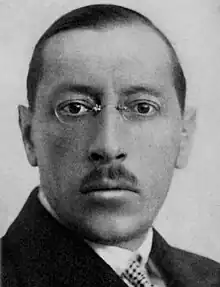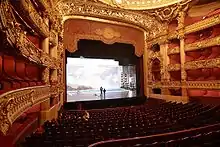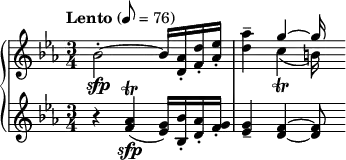
The Octet for wind instruments is a chamber music composition by Igor Stravinsky, completed in 1923.
Stravinsky’s Octet is scored for an unusual combination of woodwind and brass instruments: flute, clarinet in B♭ and A, two bassoons, trumpet in C, trumpet in A, tenor trombone, and bass trombone. Because of its dry wind sonorities, divertimento character, and open and self-conscious adoption of "classical" forms of the German tradition (sonata, variation, fugue), as well as the fact that the composer published an article asserting his formalist ideas about it shortly after the Octet's first performance, it has been generally regarded as the beginning of neoclassicism in Stravinsky's music, even though his opera Mavra (1921–22) already displayed most of the traits associated with this phase of his career (Walsh 2001, §5).
History
According to Stravinsky, he composed the Octet fairly rapidly in 1922. After completing the first movement, he composed the waltz that would become the fourth variation of the middle movement. Only after composing this waltz did the idea come to him that it might be a good subject for a variation movement. The seventh variation, a fugato, especially pleased Stravinsky, and the following third movement grew out of this final variation (Stravinsky and Craft 1963, 71). One biographer concludes that Stravinsky began composing the Octet after returning from Germany to Biarritz late in the autumn of 1922, and completed the score on 20 May 1923.[1]
However, the sketch materials reveal a more complex chronology. Twelve measures of what would become the waltz variation were composed in 1919, and the fugato variation was the first complete section to be composed, in January 1921. There is an early five-page draft of uncertain date for the beginning of the Allegro section in the first movement, at that time planned for piano and wind orchestra. The main segments of the first movement were drafted in sketches dated between 12 July and 8 August, and the full score of the movement was completed on 16 August 1922. Two days later, Stravinsky began work on the second movement by adding the previously composed fugato, and then the waltz fragment, slightly expanded. The waltz coincidentally contains the same intervals as the opening of the fugato, and on 23 August 1922, he created the theme and titled the movement "Thème avec variations monométriques". Variation D was begun next, but work was interrupted and Stravinsky finished it only on 18 November, followed by the "ribbons of scales" variation A on 1 December, variation B on 6 December, and variation C on 9 December. The Finale was completed in Paris on 20 May 1923.[2] The score was revised by the composer in 1952.

The published score does not carry a dedication, though Stravinsky said it was dedicated to Vera de Bosset.[3]
Stravinsky himself conducted the premiere of the Octet on one of Serge Koussevitzky's concerts at the Paris Opera House on 18 October 1923. This was the first time he had conducted a premiere of a new piece, though not the first time he had conducted his music in public.[4] The cavernous space cannot have been ideal for presenting such a chamber-music work, but Stravinsky later expressed satisfaction with the balance of the sound at that performance.[5]
The very first recording that Stravinsky made was of the Octet: a private recording, probably made for his own study purposes, which is now lost.[6]
Form
The Octet is in three movements:
- Sinfonia (Lento – Allegro moderato)
- Tema con variazioni (Andantino)
- Finale (Sempre
 = 116, Tempo giusto)
= 116, Tempo giusto)
The thematic and rhythmic materials of the three movements are interrelated,[7] and the second movement connects to the third without a break.
First movement
The opening Sinfonia is a comparatively rare example (despite his label of "neoclassic composer") of Stravinsky's use of sonata form.[8] His employment of this form, along with the other style elements consciously borrowed from the past, is not out of a reverent desire to perpetuate them, but rather constitutes a defiant and satirical act of mockery.[9] The opening Lento section functions like a classical introduction, presenting the background tonal structure that will also govern the main Allegro section.[10][11]
In the Allegro, Stravinsky exploits the apparent contradiction of two formal balances: one created through the parallel restatement of themes, the other through the symmetrical arrangement of themes and events on different structural layers of the composition.[12]
Second movement
In 1922, when Stravinsky was composing the second, theme-and-variations movement, he confided in a letter to Ernest Ansermet that Mozart was for him what Ingres was to Picasso. The hybrid of rondo and variation form resembles the slow movement of Mozart's E♭ major Piano Concerto, K. 482, to which it has been compared.[13] Variations 1, 3, and 6 are practically identical (all are labeled "variation A" in the score), and serve as introductions to the following variations 2, 4, and 7.[14] Stravinsky referred to this recurring introduction as the "ribbons of scales" variation.[15] The second, fourth, fifth, and seventh variations assume the characters of a march, a waltz, a can-can, and a solemn fugue, respectively.[16] The fugato is almost uniformly written in 5
8 time.[17] This seventh, final variation is particularly surprising. The theme here is scarcely recognizable, and does not seem promising as the subject for a fugue; the sound character of the variation, with its emphasis on slow-moving harmonic masses, is unearthly, and its plan is unconventional, with the subject occurring only four times.[18]
Third movement
The finale's material is based on a rhythm identified by Stravinsky in earlier works (such as The Firebird and The Rite of Spring) with the Russian circle-dance called a khorovod. This repeating, three-note syncopated rhythm with proportions 3:3:2 (![]() .
. ![]() .
. ![]() ) is especially evident in the accompanying chords at the end, but all the preceding material in the movement is built on it or contains it. The overall formal design may be represented as A–B–A′–C–A″–D–D′, where the refrain material in the A sections occurs one time fewer in each successive repetition: three times, then two times, and finally just once. In this process, the khorovod-like element becomes progressively less evident in the refrain, whereas in the intervening couplets it increases in clarity, from a disguised augmentation in the solo trumpet in section B, to a flute solo built on the original rhythmic shape in C, to the chordal accompaniment in D. The conception of a round dance is transformed here into an instrumental rondo, with a main theme resembling a baroque fugue subject.[19]
) is especially evident in the accompanying chords at the end, but all the preceding material in the movement is built on it or contains it. The overall formal design may be represented as A–B–A′–C–A″–D–D′, where the refrain material in the A sections occurs one time fewer in each successive repetition: three times, then two times, and finally just once. In this process, the khorovod-like element becomes progressively less evident in the refrain, whereas in the intervening couplets it increases in clarity, from a disguised augmentation in the solo trumpet in section B, to a flute solo built on the original rhythmic shape in C, to the chordal accompaniment in D. The conception of a round dance is transformed here into an instrumental rondo, with a main theme resembling a baroque fugue subject.[19]
Reception
Aaron Copland witnessed the world premiere in Paris, and reported the general dismay at the abrupt, inexplicable turn away from Stravinsky's well-established neo-primitivist Russian style, to what appeared to everyone as "a mess of 18th-century mannerisms". The press, too, was unanimous in condemning what seemed like a bad joke. From a perspective of several decades later, of course, it had become clear that Stravinsky was embarking on a new and important stylistic phase that was destined to influence composers everywhere by bringing out a latent objectivist tendency in the music of the period, by openly reverting to the ideals, forms, and textures of the pre-Romantic era.[20]
Not all of the early reviewers took a negative view, however. When the Octet was performed at the Salzburg Festival in 1924, by instrumentalists from Frankfurt conducted by Hermann Scherchen, an anonymous reviewer in the Times declared that, "without claiming for it, after the manner of the composer's more violent admirers, that it is a seventh Brandenburg Concerto", it displayed "a complete mastery of the medium", as well as a sure sense of form and "an ingenuity in counterpoint" with its own laws. Though finding moments of unaccustomed discords preventing acceptance of the music as "beautiful", this critic concluded that "there is so much to admire in the work that it cannot be dismissed as a piece of buffoonery".[21]
References
- ↑ White 1979, 308–309.
- ↑ Craft 1983–84, 458–462.
- ↑ White 1979, 85, 308.
- ↑ Walsh 2001, §5.
- ↑ White 1979, 313.
- ↑ Cook 2003, 177.
- ↑ Waeltner 1971, 274.
- ↑ Haimo and Johnson 1987, x.
- ↑ Straus 1987, 161.
- ↑ Haimo 1987, 45.
- ↑ Straus 1987, 159.
- ↑ Kielian-Gilbert 1991, 464.
- ↑ Kielian-Gilbert 1991, 471–472.
- ↑ Nelson 1962, 329.
- ↑ Stravinsky and Craft 1963, 71.
- ↑ Simms 1986, 279.
- ↑ White 1979, 311.
- ↑ Nelson 1962, 337.
- ↑ Waeltner 1971, 267–269, 272–273.
- ↑ Copland 1968, 72.
- ↑ Anon. 1924.
Sources
- Anon. 1924. "The Salzburg Festival: Stravinsky's Octet; The Work of English Composers". The Times (18 August): 8.
- Cook, Nicholas. 2003. "Stravinsky Conducts Stravinsky". In The Cambridge Companion to Stravinsky, edited by Jonathan Cross, 176–191. Cambridge Companions to Music. Cambridge and New York: Cambridge University Press. ISBN 978-0-521-66377-9.
- Copland, Aaron. 1968. The New Music 1900–1960, revised and enlarged edition. New York: W. W. Norton.
- Craft, Robert. 1983–84. "A. On the Symphonies of Wind Instruments. B. Toward Corrected Editions of the Sonata, Serenade, and Concerto for Two Pianos. C. The Chronology of the Octet". Perspectives of New Music 22, nos. 1 & 2 (Fall–Winter/Spring–Summer): 448–463.
- Haimo, Ethan. 1987. "Problems of Hierarchy in Stravinsky's Octet". In Stravinsky Retrospectives, edited by Ethan Haimo and Paul Johnson, 36–54. Lincoln: University of Nebraska Press.
- Haimo, Ethan, and Paul Johnson. 1987. "Editors' Preface". In Stravinsky Retrospectives, edited by Ethan Haimo and Paul Johnson, vii–xi. Lincoln: University of Nebraska Press.
- Kielian-Gilbert, Marianne. 1991. "Stravinsky's Contrasts: Contradiction and Discontinuity in His Neoclassic Music". The Journal of Musicology 9, no. 4 (Autumn): 448–480.
- Nelson, Robert U. 1962. "Stravinsky's Concept of Variations". The Musical Quarterly 48, no. 3, Special Issue for Igor Stravinsky on His 80th Anniversary (July), pp. 327–339.
- Simms, Bryan R. 1986. Music of the Twentieth Century: Style and Structure. New York: Schirmer Books; London: Collier Macmillan Publishers. ISBN 0-02-872580-8.
- Straus, Joseph N. 1987. "Sonata Form in Stravinsky". In Stravinsky Retrospectives, edited by Ethan Haimo and Paul Johnson, 141–161. Lincoln: University of Nebraska Press.
- Stravinsky, Igor, and Robert Craft. 1963. Dialogues and a Diary. New York: Doubleday.
- Waeltner, Ernst Ludwig. 1971. "Aspekte zum Neoklassizismus Strawinskys: Schlußrhythmus, Thema und Grundriß im Finale des Bläser-Oktetts 1923". In Bericht über den Internationalen Musikwissenschaftlichen Kongress Bonn 1970, edited by Carl Dahlhaus, Hans Joachim Marx, Magda Marx-Weber, and Günther Massenkeil, with Bericht über das Symposium "Reflexionen über Musikwissenschaft heute", edited by Hans Heinrich Eggebrecht, 265–274. Kassel, Basel, Tours, London: Bärenreiter-Verlag. ISBN 3-7618-0146-7.
- Walsh, Stephen. 2001. "Stravinsky, Igor (Fyodorovich)". The New Grove Dictionary of Music and Musicians, second edition, edited by Stanley Sadie and John Tyrrell. London: Macmillan.
- White, Eric Walter. 1979. Stravinsky: The Composer and His Works, second edition. Berkeley and Los Angeles: The University of California Press. ISBN 0-520-03985-8.
Further reading
- Aguilar, Victor Reyes. 2006. "Igor Stravinsky's "Octet for Wind Instruments" (1923): An Analysis and Discussion of Conducting Performance Practices". DMA diss. Los Angeles: UCLA.
- Cross, Jonathan (ed.). 2003. The Cambridge Companion to Stravinsky. Cambridge Companions to Music. Cambridge and New York: Cambridge University Press. ISBN 978-0-521-66377-9.
- Hyde, Martha Maclean. 1996. "Neoclassic and Anachronistic Impulses in Twentieth-Century Music". Music Theory Spectrum 18, no. 2 (Fall): 200–235.
- Hyde, Martha M. 2003. "Stravinsky's Neoclassicism". In The Cambridge Companion to Stravinsky, edited by Jonathan Cross, 98–136. Cambridge Companions to Music. Cambridge and New York: Cambridge University Press. ISBN 978-0-521-66377-9.
- Kielian-Gilbert, Marianne Catherine. 1981. "Pitch-class Function, Centricity, and Symmetry as Transposition Relations in Two Works of Stravinsky". PhD diss. Ann Arbor: University of Michigan.
- Lubaroff, Scott. 2004. An Examination of the Neo-classical Wind Works of Igor Stravinsky: The Octet for Winds and Concerto for Piano and Winds. Studies in the History and Interpretation of Music 102. Lewiston, New York: E. Mellen Press. ISBN 978-0-7734-6472-8.
- Stravinsky, Igor. 1924. "Some Ideas about My Octuor", translated from the French. The Arts 6, no. 1 (January): 4–6. Reprinted in Eric Walter White, Stravinsky: The Composer and His Works, second edition, 574–577. Berkeley and Los Angeles: University of California Press, 1979. ISBN 0-520-03985-8 (pbk).
- Van den Toorn, Pieter C. 1983. The Music of Igor Stravinsky. New Haven and London: Yale University Press. ISBN 0-300-02693-5.
- Wood, James R. 2007. "A Historical and Analytical Examination of the Stravinsky Octet for Wind Instruments, with a Guide to Performance Preparation of the Two Trumpet Parts". DMA diss. Denton: University of North Texas.
External links
- "Stravinsky, Igor: Octet for Wind Instruments (1922–23, rev. 1952)", programme note by Joseph Horowitz at the publisher's (Boosey & Hawkes) website.


